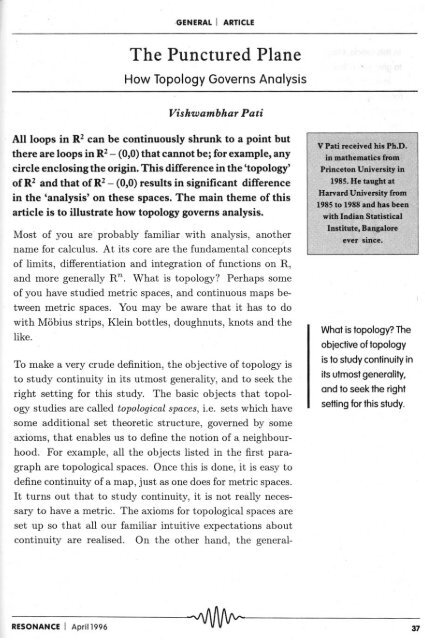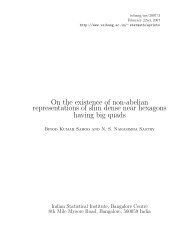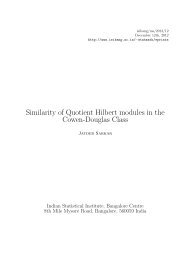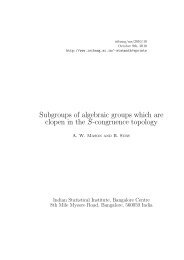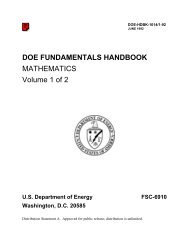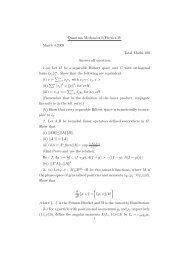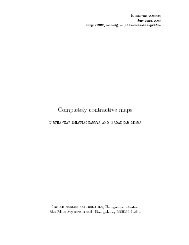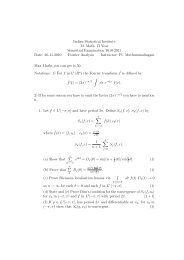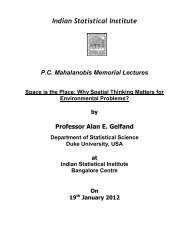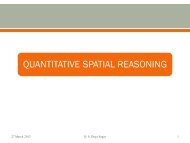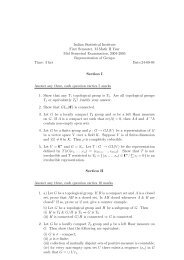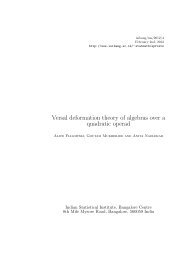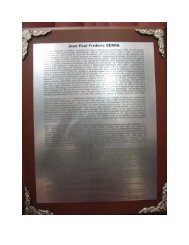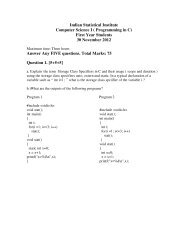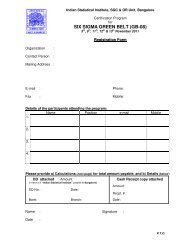The Punctured Plane
The Punctured Plane
The Punctured Plane
Create successful ePaper yourself
Turn your PDF publications into a flip-book with our unique Google optimized e-Paper software.
.GENERAL I ARTICLE<br />
<strong>The</strong> <strong>Punctured</strong><br />
<strong>Plane</strong><br />
How Topology Governs Analysis<br />
Vishwambhar Pati<br />
All loops in R2 can be continuously shnmk to a point but<br />
there are loops in R2- (0,0) that cannot be; for example, any<br />
circle enclosing the origin. This difference in the 'topology'<br />
ofR2 and that ofR2 - (0,0) results in significant difference<br />
in the 'analysis' on these spaces. <strong>The</strong> main theme of this<br />
article is to illustrate how topology governs analysis.<br />
Most of you are' probably familiar with analysis, another<br />
name for calculus. At its core are the fundamental concepts<br />
of limits, differentiation and integration of functions on R,<br />
and more generally Rn. What is topology? Perhaps some<br />
of you have studied metric spaces, and continuous maps between<br />
metric spaces. You may be aware that it has to do<br />
with Mobius strips, Klein bottles, doughnuts, knots and the<br />
like.<br />
To make a very crude definition, the objective of topology is<br />
to study continuity in its utmost generality, and to seek the<br />
right setting for this study. <strong>The</strong> basic objects that topology<br />
studies are called topological spaces, i.e. sets which have<br />
some additional set theoretic structure, governed by some<br />
. axioms, that enables us to definethe notion of a neighbourhood.<br />
For example, all the objects listed in the first paragraph<br />
are topological spaces. Once this is done, it is easy to<br />
define continuity of a map, just as one does for metric spaces.<br />
It turns out that to study continuity, it is not really necessary<br />
to have a metric. <strong>The</strong> axioms for topological spaces are<br />
set up so that all our familiar intuitive expectations about<br />
continuity are realised. On the other hand, the general-<br />
V Pati received his Ph.D.<br />
in mathematics from<br />
Princeton University in<br />
1985.He taught at<br />
Harvard University from<br />
1985to 1988and has been<br />
with Indian Statistical<br />
Institute, Bangalore<br />
ever since.<br />
What is topology? <strong>The</strong><br />
objective of topology<br />
is to sh,.rdycontinuity in<br />
its utmost generality,<br />
and to seek the right<br />
setting for this study.<br />
RESONANCE I April1996
I<br />
GENERAL I ARTICLE<br />
In this article, I hope<br />
to give you a flavour<br />
of how a<br />
topological<br />
invariant<br />
called homology<br />
governs the<br />
solvability of a<br />
problem in calculus.<br />
IP\'\<br />
~<br />
""<br />
.<br />
.~<br />
([J . ':<br />
:,<br />
.<br />
e.<br />
t"<br />
.<br />
~"."<br />
,:.::." !<br />
..<br />
~:<br />
;.<br />
..'~-. ,<br />
~...<br />
..~:..;,_.1.<br />
..<br />
~.<br />
:~:':"-"----".<br />
/-~--~~ -, ~~<br />
J ".::,1 ~":.;~::".. ~_<br />
A topologist has been<br />
defined to be a mathematician<br />
who can't tell<br />
the difference between a<br />
doughnut and a cup of<br />
coffee!<br />
ity achieved by ridding ourselves of a metric is so powerful<br />
that topology permeates all of mathematics. A continuous<br />
map between topological spaces which has a continuous inverse<br />
is called a homeomorphism. One would like to classify<br />
topological spaces upto homeomorphism (Le., without distinguishing<br />
spaces which are homeomorphic),- just as one<br />
would like to classify, say, groups upto isomorphism. For<br />
example, a doughnut is homeomorphic to a coffee cup. A<br />
property, such as connectedness, or compactness, which is<br />
preserved under homeomorphism,is called a topologicalinvariant.<br />
In this article, I hope to giveyou a flavourof how a<br />
topological invariant called homology, which we shall define,<br />
governs the solvability of a problem in calculus. For starters,<br />
let us review some several variable calculus.<br />
Statement of the Problem<br />
Let v(x, y) = (p(x, y), q(x, y)) be a smooth vector field on an<br />
open subset X of the Euclidean plane R2, i.e. both p(x, y)<br />
and q(x, y) are defined on X, and infinitely differentiable as<br />
functions on X. Those with a physics background may like<br />
to think of v as an electric field, or the velocity field of a<br />
fluid confined to the planar region X. A natural fundamental<br />
question which arises is whether there exists a potential<br />
function for this vector field. In other words, does there exist<br />
a smooth function (x, y) on X such that<br />
8<br />
p= 8x '<br />
q =<br />
8<br />
holds identically all over X? This pair of simultaneous differential<br />
equations is often abbreviated as v = V'(read<br />
gradient of ,or grad
GENERAL I ARTICLE<br />
has, for example, a line of charge, then to find the' electric<br />
field at a point you would have to take field contributions<br />
of 'infinitesimal' bits of the line, take the components along,<br />
say the x-axis, and then integrate.<br />
.For the potential, you<br />
do not need to take components, but simply integrate the<br />
potential contributiops. <strong>The</strong> other reason, which is of more<br />
interest to us here, is the matter of 'work done' in moving<br />
along a smooth path "'(. Let "'( : [0,1] -t X, where "'((t) =<br />
("'(1(t), "'(2(t)) be a smooth function of t E [0,1]. "'(is called a<br />
smooth path joining P = "'((0) to Q = "'((1). <strong>The</strong> work done<br />
along "'(in the field v is the line integral defined by :<br />
It is easier to<br />
perform<br />
summation of<br />
potentials, which<br />
are scalar valued<br />
functions, rather<br />
than vector fields.<br />
i v = 101 (v("'((t)). ~~) dt<br />
r 1<br />
(<br />
d"'(l<br />
d",(2<br />
= Jo p("'((t))dt + q("'((t))dt dt (2)<br />
where '.' denotes the dot product in R2. Clearly, if a potential<br />
function 1> exists on X, satisfying (1), then the line<br />
integral of v along "'( becomes<br />
_ r 1 d1>("'((t)) dt = 1>("'((1))-1>("'((0))<br />
- Jo dt '<br />
= 1>(Q)-1>(P) (3)<br />
by the fundamental theorem of calculus. To sum up, the<br />
work done along a path is just the differen is to be smooth on the open<br />
set X , one must have<br />
)<br />
(4)<br />
RESONANCE I April1996<br />
39
GENERAL I ARTICLE<br />
all over X. <strong>The</strong> (also smooth) function * - * is called the<br />
curl of v, and denoted curl v. <strong>The</strong> discussion above shows<br />
that a necessary condition for (1) to have a solution is that<br />
curl v = 0 identically on X (recall the statement 'curl grad<br />
is zero', from multivariate calculus). So, for example, the<br />
vector field v(x,y) = (xy,xy) on X = R2 has no potential<br />
function since its curl is not identically zero.<br />
It is quite natural to ask whether curl v = 0 is a sufficient<br />
condition for a smooth vector field v on X to have a potential<br />
function satisfyinp; (1). <strong>The</strong> rest of this note is essentially<br />
devoted to this question.<br />
For a start, let us consider the simplest case X ~ R2. In<br />
this case, the answer turns out to be yes. Indeed, definethe<br />
function 4> by<br />
{X (V<br />
4>(x,y) = Jo p(t,O)dt+Jo q(x,s)ds<br />
(5)<br />
Figure 1 <strong>The</strong> whir pool<br />
vector field.<br />
That this function satisfies (1) is an easy application of the<br />
fundamental theorems of calculus about integrals of derivatives<br />
and derivatives of integrals; we leave it as an exercise.<br />
So now we have a complete answer for a smooth vector field<br />
v on R2, viz. v = V 4> for some smooth function 4> if and only<br />
if curl v = O. This is a particular instance of the Poincare<br />
Lemma for R:. See the book by Singer and Thorpe for the<br />
general statement.<br />
What does topology have to do with all this? To elucidate<br />
this point, let us migrate from X = R2 to the punctured<br />
plane X = R2 - (0,0).<br />
Consider the smooth vector field<br />
( -y X w(x,y)= x2+y2' x2+y2 )<br />
on R2 - (0,0), which is pictured in Figure 1. Note that this<br />
vector field 'has a singularity at the origin, i.e., there is no<br />
40<br />
RESONANCE I April1996
GENERAL I ARTICLE<br />
way of extending this field to a smooth vector field on R2.<br />
You may like to think of it as the surface of an infinite river<br />
with a whirlpool at the origin. It is easy to check that this<br />
vector field is curl free on R2 - (0,0), and we may again ask<br />
whether there is a smooth potential function 4Jdefined on<br />
R2 - (0,0) such that w = '\l4J.If there were, then the earlier<br />
discusSion would imply that its line integral along a loop<br />
in R2 - (0,0) would have to be zero. On the other hand,<br />
a (hopefully empty!) boat drifting around the whirlpool<br />
would certainly go on gaining energy in the counterclockwise<br />
direction. Let us verify this (without getting into that<br />
boat!). Let ')'(t) = (cos211"t,sin211"t)where t E [0,1], be<br />
the loop going counter-clockwise once around the puncture<br />
(see Figure 1). <strong>The</strong>n w(-y(t)) = (-sin211"t,cos211"t), qg =<br />
(- 211"sin 211"t,211"cos 211"t), and the line integral of w along ')'<br />
is<br />
h w =~(( - sin 211"t)( - 211"sin 211"t) + (cos 211"t)(211" cos 211"t)) dt<br />
= 211"~1 dt = 211" (6)<br />
which is certainly non-zero. Hence we have a curl free smooth<br />
vector field w on R2 - (0,0) which is not the gradient of any<br />
potential function! Making just one puncture in R2 has<br />
completely changed its analytical nature.<br />
We can have a curl<br />
free smooth vector<br />
field Q)on R2- (0,0)<br />
which is not the<br />
gradient of any<br />
potential function!<br />
Making just one<br />
puncture in R2can<br />
completely change its<br />
analytical structure.<br />
Now I would like to dwell upon the topological characteristic<br />
of R2 - (0,0) which 'causes' this. It is well known that all<br />
loops in R2 can be continuouslyshrunk to a point, but there<br />
are loops in R2 - (0,0) that cannot be continuously shrunk<br />
to a point. To make all this precise, we need a little bit of<br />
'technology' .<br />
Some Planar Topology<br />
Let X denote an open subset of R2. A piecewise smooth path<br />
in X is a map')' : [0,1] --+ X such that (i) ')' is continuous,<br />
RESONANCEI April1996<br />
41
I<br />
GENERAL I ARTICLE<br />
and (ii) there is a subdivision 0 = ao < a1 < ... < ak = 1<br />
of [0,1] such that "( is smooth on each of the sub-intervals<br />
Ij = [aj, aj+1]' "((0) is called the initial point and "((1) the<br />
end point of "(. <strong>The</strong> inverse path to "( is the path "(-1 defined<br />
by "(-l(t) = "((l-t). We shall now refer to piecewise smooth<br />
paths simply as paths, for brevity. As before, a loop will<br />
mean a path "( whose initial and end points are the same<br />
point x. In this case we say the loop "( is based at x.<br />
If "( and 7 are two paths such that the end point "((1) of "(<br />
is the initial point 7(0) of 7, then one can form the composite<br />
path "( * 7 defined by "( * 7(t) = "((2t) for 0 $ t $ !<br />
and = 7(2t - 1) for! $ t $ 1. (This is the reason for introducing<br />
piecewise smooth paths, because the composite of<br />
smooth paths need not be a smooth path, but the composite<br />
of piecewise smooth paths is piecewise smooth.) In particular,<br />
we can compose two loops based at the same point.<br />
<strong>The</strong> constant path Cx at a point x E X is defined by Cx(t) = x<br />
for all t E [0,1]. Henceforth, we shall always assume that<br />
X is a path connected open subset of R2, i.e.. given any two<br />
points P and Q in X, there is a path "( in X with P as its<br />
initial and Q as its end point.<br />
Given a smooth vector field v = (p,q) on X, and a piecewise<br />
smooth path "( in X, we can define the line integral<br />
k-1<br />
1 aj+l d"(l<br />
d,,(2<br />
v = ~ p("((t))-<br />
( d + q("((t))- dt<br />
-y j=O aj t dt<br />
1<br />
)<br />
With this definition, and the standard facts about change<br />
of variables in integration, it is easy to see that I-Y*Tv =<br />
I-yv + IT v and I-y-l v = - I-yv. Also, for the constant path<br />
Cx at x, we have Ie",V = o.<br />
One is now equipped to do some algebra with (piecewise<br />
smooth) loops. Let X be a path-connected open subset of<br />
,42<br />
RESONANCE I April1996
GENERAL I ARTICLE<br />
R2, as before. I would like to define an equivalence relation<br />
on loops in X as follows. Say that the loops '"'Iand l'<br />
are equivalent (or homologous, or freely homotopic) if there<br />
exists a piecewise smooth map F : [0,1] x [0,1] -> X such<br />
that (i) F(t,O) = '"'I(t), F(t,1) = 1'(t) for all t E [0,1], (ii)<br />
F(O,s) = F(l,s) for all s E [0,1]. Such a map is called a<br />
(free) homotopy. We write '"'Irv l' to denote that '"'Iis equivalent<br />
to 1". You should verify that this is an equivalence<br />
relation.<br />
One intuitively thinks of '"'Is = F ( , s) as a continuous one<br />
parameter family of loops evolving from '"'Iat s = 0 to l'<br />
at s = 1. Finally, given a loop '"'Iin X, and an arbitrary<br />
point x EX, there is a loop ;:ywhich is equivalent to '"'I,<br />
and which is based at x. For, take a fixed path a joining<br />
x to y = '"'1(0) = '"'1(1),which is possible by the path connectedness<br />
of X. Define;:Y= a * '"'I * a-I. Figure 2 should<br />
enable you to construct a homotopy. Because of this, one<br />
can compose equivalence classes of loops. If '"'Iand l' represent<br />
two equivalence classes, the above remark allows us to<br />
assume without loss of generality that '"'Iand l' are based at<br />
the same point, and we may define '"'I+ l' to be the equivalence<br />
class of the loop '"'I* 1'. We will omit the proof that<br />
this operation is well-defined, i.e. that '"'Irv '"'I', l' rv 1" implies<br />
'"'I* l' rv '"'I'* 1", though it isn't difficult to prove this,<br />
by 'pasting homotopies'. <strong>The</strong> notation '+' is meant to indicate<br />
that the operation is abelian, and it is not difficult<br />
to show that '"'I * l' and l' * '"'Iare equivalent. If '"'Iis a loop<br />
with '"'1(0)= '"'1(1) = x, you may verify, for example, that<br />
'"'I * Cx rv '"'Irv Cx * '"'I. Also, '"'I* '"'1-1 rv Cx rv '"'1-1* '"'I. Thus, the<br />
equivalence class of the constant loop (at any point) is the<br />
identity element, and the inverse of (the equivalence class<br />
of) '"'I is (the equivalence class of) the loop '"'I -1. For notational<br />
simplicity, we shall denote a loop and its equivalence<br />
class by the same letter,<br />
say, '"'I,1', etc.<br />
Figure 2<br />
around.<br />
MOiling loops<br />
<strong>The</strong> abelian group of these equivalence classes of loops in<br />
RESONANCE I April1996<br />
43<br />
;,
GENERAL I ARTICLE<br />
X is a very important one, and is called the first homology<br />
group of X, and denoted HI (X). It was essentially invented<br />
by Poincare and Riemann for their study of Riemann surfaces.<br />
I claim that the distinction betweenthe Euclidean plane R2<br />
and the punctured plane R2 - (0,0) is detected by the first<br />
homology group. First, let us see that HI (R2) is the trivial<br />
group {O}. This is because the homotopy<br />
F(t, s) = (1- sh(t)<br />
<strong>The</strong> distinction<br />
between the<br />
Euclideanplane R2<br />
. and the punctured<br />
plane R2 - (0,01is<br />
detected by the first<br />
homology group.<br />
makes any loop..., equivalent to the trivial loop, so there is<br />
only the equivalence class of the constant loop in HI (R2),<br />
which therefore is the trivial group ! In fact, this argument<br />
shows that the first homology group of any convex (in fact<br />
any starlike) open subset of R2 is trivial. For more on HI,<br />
see the Greenberg lectures on algebraic topology or the book<br />
by Bott and Th.<br />
Of course, R2 - (0,0) is not convex, or starlike, and one<br />
would like to compute its first homology group. First, let<br />
me try to convince you that it is non-trivial. For this, we<br />
will need the following lemma, which is the crucial bridge<br />
between topology and calculus.<br />
Let X be a path connected open subset of R2, and v be a<br />
curl free smooth vector field on it. <strong>The</strong>n, for two loops ...,<br />
and T in X such that..., rv<br />
T, we have J')'v = JTV.<br />
To see this, first let us make the simplifying assumption<br />
that both ..., and T are smooth, and that the homotopy<br />
F : [0,1] x [0,1] -+ X between them, satisfying F(t,O) =<br />
...,(t), F(t,1) = T(t), is also smooth. We let a denote the<br />
path defined by a(s) = F(O,s) = F(1, s). Write F(t, s) =<br />
(FI (t, s), F2(t, s» in terms of its component functions. Write<br />
v(x, y) = (p(x, y), q(x, y), and for brevity let us denote partial<br />
differentiation by subscripts e.g. Pll = %, FI,s = aa~1<br />
44<br />
RESONANCE I April1996
i<br />
GENERAL I ARTICLE<br />
etc. We will use the smooth homotopy F to 'pullback' the<br />
vector field v from X to a smooth vector field w on the<br />
square [0,1] x [0, 1]. More precisely, w(t, s) = (p(t, s), q(t, s))<br />
where:<br />
p(t,s)<br />
q(t,s)<br />
= p(F(s, t))Fl,t + q(F(s, t))F2,t<br />
= p(F(s, t))Fl,s + q(F(s, t))F2,s<br />
This seems a bit concocted, but is got from substituting<br />
Fl(t, s) for x, F2(t, s) for y in the 'differential' p dx + q dy,<br />
and reading the coefficients of dt and ds in the resulting<br />
differential. Using the chain rule, one directly computes<br />
curl w(t, s) = (qt(t, s) - Ps(t,s))<br />
= (qx(F(t, s)) - py(F(t, s))) (Fl,tF2,s - Fl,sF2,d<br />
=0<br />
since v curl free implies qx - Py = 0. Thus this new vector<br />
field w on [0,1] x [0,1] is also curl free. Now, by Green's<br />
<strong>The</strong>orem, (see page 134 of Spivak's book), we have<br />
Atwo-dimensional analogue of<br />
the fundamental theorem of integral<br />
calculus expresses a<br />
double integral over a planar<br />
region, R, as a line integral<br />
taken along a path determined<br />
by the boundary of Rwhenever<br />
the integrand is a partial derivative.<br />
This result is usually<br />
anributed to G Green and is<br />
known as Green's theorem. In<br />
fact it appeared earlier in the<br />
work of Lagrange and Gauss.<br />
where the second line is the line integral of w along the<br />
boundary of the square, and the third line follows by substituting<br />
the definition of wand change of variables. (If you<br />
want to avoid Green's theorem, use the fact that w is curl<br />
free on [0,1] x [0,1] implies the existence of a potential function<br />
1/Jconstructed exactly as we did for R2 in (5). <strong>The</strong>n the<br />
second equation above is true since the line integral of w on<br />
the closed loop defined by the (counterclockwise) boundary,<br />
of [0, 1] x [0,1], will have to be zero, by (3).)<br />
RESONANCEI April1996<br />
45'
GENERAL I ARTICLE<br />
For the more general piecewise smooth situation, one subdivides<br />
the square [0,1] x [0,1] into small subsquares on each<br />
of which the homotopy is smooth, and replaces the integral<br />
of curl w on each subsquare by a line integral of w on its<br />
boundary. Adding up for all these subsquares, the line integrals<br />
on all the internal edges cancel pairwise, and what<br />
remains in the end, as before, is the line integral of w on the<br />
boundary of [0,1] x [0,1]. This proves the lemma.<br />
1<br />
Solution of the Problem<br />
To get back to our story now, let us review the opening<br />
discussion about solving (1) for R2 in the light of homology.<br />
Note that since every loop in R2 is equivalent to the ronstant<br />
loop or trivial loop, the lemma above implies that the line<br />
integral of a curl free vector field along any loop is equal<br />
to the line integral around the constant loop, which is zero.<br />
Furthermore, if ')'1 and ')'2 are two paths joining the point<br />
p to the point Q in R2, ')' = ')'1 * ')'2"1 is a loop based at<br />
P, so 0 = J"( v = J"(1 V - J,,(2v for a curl free field v, which<br />
implies that the work done along a path in a curl free field<br />
depends only on thp. p.nd-points of the path. This is precisely<br />
the statement (3). Thus for a curl free v on R2, we may<br />
define the potential function 4J(x,y) = J"( v where')' is a.ny<br />
path joining a predetermined point P to the moving point<br />
Q = (x, y). We chose one such path in (5), but could have<br />
chosen any other.<br />
On the other hand, for R2 - (0,0), we have the curl free<br />
(whirlpool) vector field w introduced earlier, whose integral<br />
along the loop ')'(t) = (cos21rt,sin21rt) is non.:zero. So the<br />
lemma above implies, in particular, that this loop rannot bp.<br />
equivalent to the trivial loop !<br />
In other words, the homology group Hl(R2 - (0,0)) is nontrivial.<br />
46 RESONANCE I April1996
Irl<br />
,II<br />
.<br />
in<br />
GENERAL I ARTICLE<br />
In fact, if we consider<br />
the loops ')'11(t) = (cos 27rnt, sin 27rnt)<br />
for nEZ, we see that J-Yn;".)= 27rn, so that ')'11cannot be<br />
equivalent to ')'m for n t= m. Thus the first 'homology group<br />
of R2 - (0,0) is at least as large as the group of integers.<br />
In fact, it turns out (though the proof is quite non-trivial)<br />
that the first homology of the punctured plane HI (R 2 -<br />
(0,0)) ::: Z, with the loop ')'n introduced above representing<br />
the integer n. So every loop')' in R2 - (0,0) is equivalent to<br />
some ')'11'and in view of the preceding lemma, this integer n<br />
is determined by the relation 27rn = J-y;".).<strong>The</strong> integer n is<br />
called the winding number of ')' about (0,0). For the snaky<br />
loop in Figure 1, for example, the winding number is - 2.<br />
For more on this fascinating topic, and the connections with<br />
complex analysis, see chapter 4 of the book by Ahlfors.<br />
To tie up this discussion, it would be very pleasing if instead<br />
of throwing up one's hands about the insolubility of (1), one<br />
could use the fact that HI (R2 - (0,0)) ::: Z to give a quantitative<br />
answer regarding (1). For this we will use a very<br />
beautiful theorem, which is due to Georges de Rham. Note<br />
that our foregoing lemma says that for X a path connected<br />
open subset of R2, the line integral J-yv = 0 for a curl free<br />
field v on X if ')' is equivalent to a constant loop in X. (In<br />
fact, this is a reformulation of the lemma).<br />
<strong>The</strong> de Rham theorem (in this particular situation) asserts<br />
the following: If for a curl free vector field v we have that<br />
J-yv = 0 for all loops')' in X, then<br />
function 4Jon X.<br />
Now let v be a curl free vector<br />
v = \l4J for some smooth<br />
field on R2 - (0,0). Compute<br />
the line integral J-Ylv, where ')'1 (t) = (cos 27rt, sin 27rt) is the<br />
generating loop for H1(R2 - (0,0)). This will be some real<br />
number Q, say. Since J-Ylw = 27r,where w is the whirlpool<br />
II<br />
'~II<br />
I"I<br />
II<br />
1~lb<br />
II<br />
II<br />
II<br />
ill<br />
11'1<br />
III<br />
II<br />
II<br />
RESONANCE<br />
I April1996<br />
-<br />
47 "<br />
II
GENERAL I ARTICLE<br />
vector<br />
field, it follows that<br />
1<br />
(v - .!2:...w)= 0<br />
')'1 211"<br />
Since 1'1 is a generator for H dR2 - (0,0)), and the line<br />
integral over a sum of loops is the sum of the line integrals<br />
over those loops, it follows that<br />
Suggested<br />
Reading<br />
M. Spivak. Calculus on<br />
Manifolds. Benjamin.<br />
1965.<br />
L Ahlfors. Complex<br />
Analysis.McGraw Hill.<br />
1966.<br />
MJ Greenberg. Lec:tureson<br />
Algebraic Topology.<br />
Benjamin.I967.<br />
I M Singer. J A Thorpe.<br />
Lecture Notes in £1-<br />
ementaryTopology and<br />
Geometry. Springer<br />
UTM.1967.<br />
R Bott. L Tu. Differential<br />
Forms in Algebraic<br />
Topology,Springer<br />
GTM 82. 1982.<br />
for all n E Z. Since every loop l' in R2 - (0,0) is equivalent<br />
to 1'n '" n1'1 for some integer n, and v - 2~"'"is curl free, it<br />
follows that J')'(v - 2~""')= 0 for p.vP.ryloop l' in R2 - (0,0).<br />
Thus, by de Rham's theorem, we have v -.~ = \l
GENERAL I ARTICLE<br />
More generally, for X as above, given a de Rham cohomology<br />
class represented<br />
by a curl free field v, we get a natural<br />
abelian group homomorphism Bv : HI (X) ~ R, which<br />
takes the homology class of a loop 'Yto J"Yv. That this map<br />
v .~ Bv is well defined follows from the foregoing discussion.<br />
<strong>The</strong> full force of the de Rham theorem is: This map<br />
B : H1{X) ~ homz{Hl{X),R) is an isomorphism of R-<br />
vector spaces. <strong>The</strong> symbol on the right side denotes abelian<br />
group homomorphisms, and it is an R vector space via pointwise<br />
scalar multiplication. For a proof, see the book by Bott<br />
and Tu or the book by Singer and Thorpe.<br />
Address<br />
for correspondence<br />
VPathi<br />
Indian Statistical Institute,<br />
8th Mile,Mysore Road<br />
Bangalore 560 059, India<br />
Finally, the first homology group HI (X) can be defined using<br />
continuous loops and homotopies, instead of piecewise<br />
smooth loops and homotopies. Certain approximation theorems<br />
say that the homology remains unchanged. This clearly<br />
makes Hl{X) a topological invariant. <strong>The</strong> de Rham theorem<br />
therefore asserts that the vector space H1{X), which<br />
is a purely analytical object governing the solvability of a<br />
system of first order partial differential equations, is in fact<br />
a topological invariant. So, for example, if you took any<br />
open starlike subset of R2, and punched out a closed disc<br />
contained in its interior, the space you'd get has the same<br />
first de Rham cohomology as the punctured plane ! In particular,<br />
the above analysis of curl free fields on R2 - (O,O)<br />
applies to such a space.<br />
<strong>The</strong> reader may want to guess what happens to homology<br />
and de Rham cohomology for X = R2 - F, where F is a Flgul'fl3 <strong>The</strong>fDnJs<br />
finite set of points. I urge you to try. I also leave you with<br />
a drawing (Figure 3) of the torus that you may want to<br />
analyse.<br />
RESONANCE I April1996 · · 49


